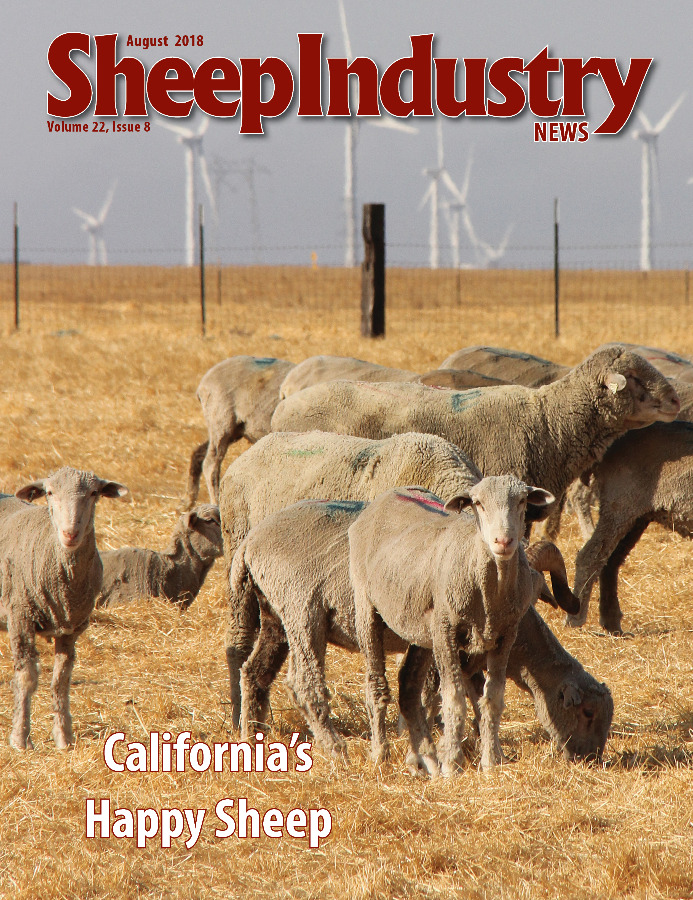
- August 2018
- President’s Notes
- Jerry King Cartoon
- ALB White Paper Calls for Industry Changes
- Japan Reopens to American Lamb
- Ninth Circuit Court Hears Montana Grazing Appeal
- Superior Farms Looks for Innovation in the Sheep Tank
- San Francisco Lamb Jam
- Fear Mongering & The Wild Sheep Foundation
- Around the States
- Market Report
- The Last Word
Around the States
Montana
Wool Provides Erosion Control
The stuff of socks, sweaters and high-tech underwear now has yet another use, according to a Montana State University study: revegetating roadsides to prevent erosion.
At a road cut along Highway 287 near Three Forks, Mont., healthy patches of native grasses are a testament to the benefits of using wool, said Rob Ament, a research scientist at the Western Transportation Institute in MSU’s Norm Asbjornson College of Engineering.
When Ament’s research team began the project four years ago, it suspected wool might have advantages compared to straw and shredded coconut hull used in traditional erosion control blankets, which buffer slopes against sun and rain until seeds germinate and plants take hold.
“We were astonished by the vigorous plant growth,” Ament said during a recent visit to the site. At the square-meter plots that received erosion blankets made of wool blended with straw, the team observed three to four times more perennial grasses – a result Ament called “stunning.”
Eli Cuelho, a former research engineer at WTI, also contributed to the project, as did Stuart Jennings and Monica Pokorny at KC Harvey Environmental, a Bozeman-based consulting firm specializing in reclamation. Pokorny, who now works at the Bozeman office of the Natural Resources Conservation Service, worked with Ament to develop the wool products and conduct the field trials.
Revegetating disturbed ground along roadsides is required by various laws to prevent takeover by noxious weeds and runoff of sediment, which can harm fish and other aquatic life, and it also contributes to the longevity of the roadbed by reducing pooling water, according to Phil Johnson. He oversaw roadside reclamation for the Montana Department of Transportation for 25 years before retiring in 2017. Prior to the experiment, MDT had seeded the road cut in a traditional manner with a seed drill. But the plants on the exposed, west-facing slope had difficulty surviving, and the agency recommended the road cut for the experiment, according to Ament.
“We picked a really harsh site,” Ament said. “We didn’t want it to be easy.”
Some erosion-preventing wool products were available internationally, Ament said. But they were prohibitively expensive to ship and weren’t designed specifically for revegetation.
Ament and Pokorny traveled to three Montana mills and worked with them to produce shredded wool, which was then sent to a Minnesota manufacturer with the specialized equipment for blending the wool with straw to produce the erosion blankets. The researchers then seeded the Highway 287 road cut with native grasses and laid down the wool erosion blankets side by side with various other erosion blankets. They observed the site periodically and measured the growth of the grasses during the course of three years.
Ament suspects that the wool holds more moisture for a longer period than other materials. And wool, which is about 17 percent nitrogen, likely has a fertilizing effect on the plants as it slowly biodegrades. Ament said that wool also appears to adhere better to soil on steep embankments.
Ament noted that if wool were widely adopted for erosion control, it could support local manufacturing of the blankets as well as create a significant new market for Montana’s wool growers. Low-grade wool that is otherwise discarded could potentially be used.
Source: Montana State University
Texas
Teams Win 4-H, FFA Wool Judging Contests
The Kimble County 4-H senior wool judging team took top honors at the 58th National 4-H Wool Judging Contest in Sonora recently.
The contest and a similar competition – the 18th Annual FFA Wool Judging Contest – highlighted the 81st annual Sonora Wool and Mohair Show June 19-21.
The Kimble County 4-H team garnered 1,756 points to edge out the Goshen County, N.M., team’s 1,392 points. Kimble County team members were Braydon Robertson, Caleb Kott, Quentin Schulze and Cole Levien. Robertson earned high individual honors.
The Hondo High School FFA team won the National FFA Wool Judging Contest with a total score of 1,803 points. The Seminole High School FFA team took second. Team members for Hondo High School were Camryn Rothe, Cassie Bendele, Laurell Pfeiffer and Lillian Davis. Rothe nabbed the contest’s high individual honors.
The Kerr County 4-H team won the sweepstakes award by garnering the most total points from all the contests.
The national 4-H and FFA wool judging contests are the premier events of the Sonora Wool and Mohair Show.
Source: Texas A&M AgriLife

